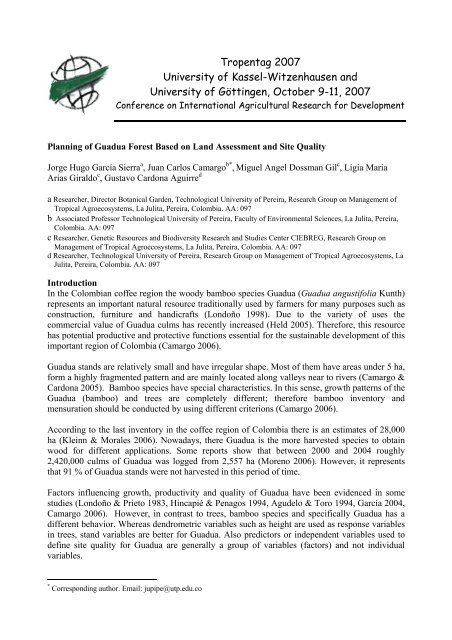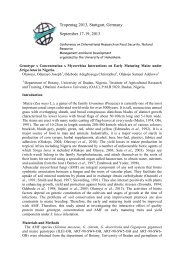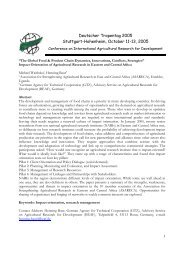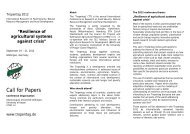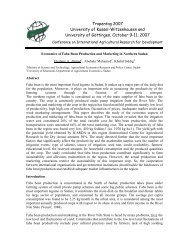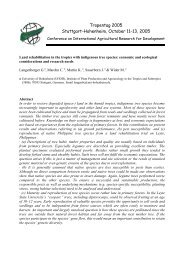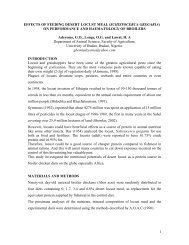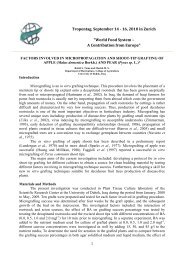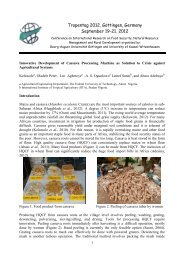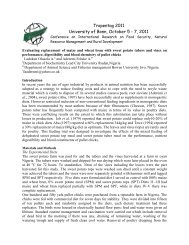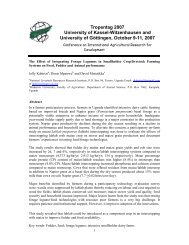Tropentag 2007 University of Kassel-Witzenhausen and University ...
Tropentag 2007 University of Kassel-Witzenhausen and University ...
Tropentag 2007 University of Kassel-Witzenhausen and University ...
- TAGS
- tropentag
- tropentag.de
You also want an ePaper? Increase the reach of your titles
YUMPU automatically turns print PDFs into web optimized ePapers that Google loves.
<strong>Tropentag</strong> <strong>2007</strong><br />
<strong>University</strong> <strong>of</strong> <strong>Kassel</strong>-<strong>Witzenhausen</strong> <strong>and</strong><br />
<strong>University</strong> <strong>of</strong> Göttingen, October 9-11, <strong>2007</strong><br />
Conference on International Agricultural Research for Development<br />
Planning <strong>of</strong> Guadua Forest Based on L<strong>and</strong> Assessment <strong>and</strong> Site Quality<br />
Jorge Hugo García Sierra a , Juan Carlos Camargo b* , Miguel Angel Dossman Gil c , Ligia Maria<br />
Arias Giraldo c , Gustavo Cardona Aguirre d<br />
a Researcher, Director Botanical Garden, Technological <strong>University</strong> <strong>of</strong> Pereira, Research Group on Management <strong>of</strong><br />
Tropical Agroecosystems, La Julita, Pereira, Colombia. AA: 097<br />
b Associated Pr<strong>of</strong>essor Technological <strong>University</strong> <strong>of</strong> Pereira, Faculty <strong>of</strong> Environmental Sciences, La Julita, Pereira,<br />
Colombia. AA: 097<br />
c Researcher, Genetic Resources <strong>and</strong> Biodiversity Research <strong>and</strong> Studies Center CIEBREG, Research Group on<br />
Management <strong>of</strong> Tropical Agroecosystems, La Julita, Pereira, Colombia. AA: 097<br />
d Researcher, Technological <strong>University</strong> <strong>of</strong> Pereira, Research Group on Management <strong>of</strong> Tropical Agroecosystems, La<br />
Julita, Pereira, Colombia. AA: 097<br />
Introduction<br />
In the Colombian c<strong>of</strong>fee region the woody bamboo species Guadua (Guadua angustifolia Kunth)<br />
represents an important natural resource traditionally used by farmers for many purposes such as<br />
construction, furniture <strong>and</strong> h<strong>and</strong>icrafts (Londoño 1998). Due to the variety <strong>of</strong> uses the<br />
commercial value <strong>of</strong> Guadua culms has recently increased (Held 2005). Therefore, this resource<br />
has potential productive <strong>and</strong> protective functions essential for the sustainable development <strong>of</strong> this<br />
important region <strong>of</strong> Colombia (Camargo 2006).<br />
Guadua st<strong>and</strong>s are relatively small <strong>and</strong> have irregular shape. Most <strong>of</strong> them have areas under 5 ha,<br />
form a highly fragmented pattern <strong>and</strong> are mainly located along valleys near to rivers (Camargo &<br />
Cardona 2005). Bamboo species have special characteristics. In this sense, growth patterns <strong>of</strong> the<br />
Guadua (bamboo) <strong>and</strong> trees are completely different; therefore bamboo inventory <strong>and</strong><br />
mensuration should be conducted by using different criterions (Camargo 2006).<br />
According to the last inventory in the c<strong>of</strong>fee region <strong>of</strong> Colombia there is an estimates <strong>of</strong> 28,000<br />
ha (Kleinn & Morales 2006). Nowadays, there Guadua is the more harvested species to obtain<br />
wood for different applications. Some reports show that between 2000 <strong>and</strong> 2004 roughly<br />
2,420,000 culms <strong>of</strong> Guadua was logged from 2,557 ha (Moreno 2006). However, it represents<br />
that 91 % <strong>of</strong> Guadua st<strong>and</strong>s were not harvested in this period <strong>of</strong> time.<br />
Factors influencing growth, productivity <strong>and</strong> quality <strong>of</strong> Guadua have been evidenced in some<br />
studies (Londoño & Prieto 1983, Hincapié & Penagos 1994, Agudelo & Toro 1994, García 2004,<br />
Camargo 2006). However, in contrast to trees, bamboo species <strong>and</strong> specifically Guadua has a<br />
different behavior. Whereas dendrometric variables such as height are used as response variables<br />
in trees, st<strong>and</strong> variables are better for Guadua. Also predictors or independent variables used to<br />
define site quality for Guadua are generally a group <strong>of</strong> variables (factors) <strong>and</strong> not individual<br />
variables.<br />
* Corresponding author. Email: jupipe@utp.edu.co
Planning <strong>of</strong> Guadua bamboo forest is a priority for government institutions responsible <strong>of</strong> giving<br />
principles for forest management. However, information collected in inventories <strong>and</strong> forest plans<br />
usually are unarticulated. In addition, because <strong>of</strong> harvesting is done in small areas the<br />
productivity estimate per unit <strong>of</strong> production is low.<br />
In this context, to achieve a true improvement <strong>of</strong> forest sector based on Guadua is complicated.<br />
Besides, government institutions in charge <strong>of</strong> promoting the development <strong>of</strong> forest sector can not<br />
provide a guide for an adequate management <strong>of</strong> Guadua bamboo forest in the Colombian c<strong>of</strong>fee<br />
region.<br />
Developing simple models to integrate spatial information <strong>and</strong> attributes <strong>of</strong> l<strong>and</strong> <strong>and</strong> Guadua<br />
st<strong>and</strong>s contributes with planning <strong>of</strong> Guadua forest. Thus the use <strong>of</strong> tools supported on geographic<br />
information systems (GIS) eases the implementation <strong>and</strong> building <strong>of</strong> these models.<br />
In this work are presented the main issues <strong>of</strong> the Guadua forest plan carried out for the c<strong>of</strong>fee<br />
region <strong>of</strong> Colombia. The aptitude <strong>of</strong> l<strong>and</strong>s for Guadua plantations <strong>and</strong> the qualification <strong>of</strong> Guadua<br />
st<strong>and</strong>s in terms <strong>of</strong> productivity were integrated in a simple model by using a GIS. The model<br />
allowed to obtain a proposal for consolidating units <strong>of</strong> forest management (UFM) as a base to<br />
lead forest development in the c<strong>of</strong>fee region <strong>of</strong> Colombia <strong>and</strong> contribute to an adequate<br />
management <strong>and</strong> promoting <strong>of</strong> this natural resource in the Colombian c<strong>of</strong>fee region. Also this<br />
experience could be replied in tropical areas with fragmented forests.<br />
Materials <strong>and</strong> Methods<br />
Study area<br />
This study was carried out in the c<strong>of</strong>fee region <strong>of</strong> Colombia in an approximate area <strong>of</strong> 5.766.397,<br />
whereas guadua st<strong>and</strong> qualification <strong>and</strong> consolidation <strong>of</strong> UFM was done only in 17 municipalities<br />
(470.328 ha). These municipalities were previously selected by government institutions due to<br />
high commercial activities associated to Guadua.<br />
Development <strong>of</strong> models for l<strong>and</strong> assessment <strong>and</strong> units <strong>of</strong> forest management<br />
To define l<strong>and</strong> capability <strong>and</strong> potential areas for establishing Guadua plantations in five states <strong>of</strong><br />
the Colombian c<strong>of</strong>fee region, 24 variables were used in analyses to develop the model. These<br />
variables were included within five factors which represent site conditions: topography, climate,<br />
soils, l<strong>and</strong>scape ecology <strong>and</strong> socioeconomics. By using a simple decision model based on the<br />
above mentioned five factors, it was feasible to define four classes <strong>of</strong> l<strong>and</strong> capability: low,<br />
marginal, moderate <strong>and</strong> high.<br />
In order to consolidate the UFM (only for 17 municipalities), additional information on volume<br />
<strong>of</strong> harvesting <strong>and</strong> characteristic <strong>of</strong> Guadua st<strong>and</strong>s related to site quality was included in the<br />
model. As a complement information on Guadua forest inventories <strong>and</strong> baseline information on<br />
soils, climate conditions, geomorphology, environmental services <strong>and</strong> socioeconomic aspects,<br />
also was included. Thus, three classes <strong>of</strong> UFM were identified according <strong>of</strong> productivity level<br />
low, moderate <strong>and</strong> high. The s<strong>of</strong>tware Arc View 3.3 <strong>and</strong> its extensions spatial analyst <strong>and</strong> 3D<br />
analyst were used. Also the extension Model Builder included within spatial analyst 2.0 provided<br />
tools to develop the model.<br />
Results <strong>and</strong> Discussion<br />
Merely 2% <strong>of</strong> the evaluated total area resulted with high capability for Guadua production. This<br />
area is located close to urban centers where are sited most <strong>of</strong> Guadua st<strong>and</strong>s (Figure 1). The main<br />
limitation for Guadua production was the lack <strong>of</strong> roads (to access) <strong>and</strong> the absence <strong>of</strong> places for
marketing. Also areas over 2000 m <strong>of</strong> elevation were immediately excluded, because <strong>of</strong> Guadua<br />
does not grow under these conditions.<br />
Regarding to UFM, those defined at the category <strong>of</strong> high productivity represent 19 % <strong>of</strong> the total<br />
area <strong>of</strong> municipalities analysed (Figure 1). Due to the characteristics <strong>of</strong> UFM in this category, it<br />
is feasible to develop intensive programs <strong>of</strong> forest management, since all aspects show a<br />
favorable level. Other UFM at the categories <strong>of</strong> moderate <strong>and</strong> marginal productivity could<br />
potentially become <strong>of</strong> high productivity. It is workable only if the volume <strong>of</strong> harvest increase <strong>and</strong><br />
some conditions as access are improved (Figure 2).<br />
Figure 1. Capability <strong>of</strong> l<strong>and</strong> for Guadua production. C<strong>of</strong>fee region <strong>of</strong> Colombia.<br />
Units Units <strong>of</strong> <strong>of</strong> Forest Forest Management<br />
Management<br />
Other<br />
Other<br />
L<strong>and</strong> L<strong>and</strong> Unit<br />
Unit<br />
Low Low Capability<br />
Capability<br />
Marginal Marginal Capability<br />
Capability<br />
Moderate Moderate Capability<br />
Capability<br />
High High Capability<br />
Capability<br />
Low Low productivity<br />
productivity<br />
Moderate Moderate Productivity<br />
Productivity<br />
High High Productivity<br />
Productivity<br />
Area Area (ha)<br />
(ha)<br />
67281<br />
67281<br />
3345448<br />
3345448<br />
1614691<br />
1614691<br />
124515<br />
124515<br />
Area<br />
Area<br />
(ha)<br />
(ha)<br />
83529<br />
83529<br />
162057<br />
162057<br />
137097<br />
137097<br />
87645<br />
87645<br />
Figure 2. Units <strong>of</strong> forest management for 17 municipalities in the c<strong>of</strong>fee region <strong>of</strong> Colombia.<br />
%<br />
12<br />
12<br />
58<br />
58<br />
28<br />
28<br />
2<br />
%<br />
16<br />
16<br />
35<br />
35<br />
29<br />
29<br />
19<br />
19
UFM also represent areas with potential for establishing Guadua plantations. In addition, Guadua<br />
st<strong>and</strong>s located within these units were qualified in terms <strong>of</strong> productivity, quality <strong>and</strong> as potential<br />
protected areas. Hence the conformation <strong>of</strong> UFM is significant as strategy to promote the<br />
management <strong>of</strong> small Guadua st<strong>and</strong>s. The fragmented pattern <strong>and</strong> small size <strong>of</strong> Guadua st<strong>and</strong>s<br />
could be a drawback. However, these forest areas included as a part <strong>of</strong> UFM can be seen as a<br />
opportunity to integrate forest management <strong>and</strong> a better way for forest planning.<br />
Moreover, management <strong>and</strong> market <strong>of</strong> Guadua culms is incorporated within a UFM plan <strong>and</strong> not<br />
separately. Plans <strong>of</strong> management <strong>and</strong> strategies <strong>of</strong> marketing can now be done according to the<br />
specifics characteristics <strong>of</strong> UFM.<br />
The worth <strong>of</strong> the issues is because provided a tool for planning Guadua forest. Consequently,<br />
contribute to an adequate management <strong>of</strong> this natural resource in the Colombian c<strong>of</strong>fee region.<br />
An additional value <strong>of</strong> this experience is because it could be replied in tropical areas with<br />
fragmented forests.<br />
Conclusions<br />
The implemented model for forest planning was useful to define L<strong>and</strong> capability <strong>and</strong> also Units<br />
<strong>of</strong> Forest Management. Nowadays, government institutions can lead the planning <strong>of</strong> Guadua<br />
st<strong>and</strong>s based on this model. In the other h<strong>and</strong>, the units <strong>of</strong> forest management are an alternative<br />
against drawbacks relate to size <strong>of</strong> guadua forest <strong>and</strong> their fragmented pattern because integrated<br />
forest management is feasible.<br />
Acknowledges<br />
This work was carried out within the project “Estrategias para la conformación y el<br />
fortalecimiento de empresas rurales con base en la Guadua (Guadua angustilfolia Kunth) en la<br />
zona cafetera de Colombia”, funded by COLCIENCIAS. Also some infomation was derivated<br />
from the Project “Valoración de bienes y servicios de la biodiversidad en paisajes rurales<br />
colombianos complejo ecoregional Andes del norte”, conducted by the Genetic Resources <strong>and</strong><br />
Biodiversity Research <strong>and</strong> Studies Center, CIEBREG.<br />
References<br />
Agudelo, B., Toro, I. 1994: Evaluación del desarrollo de los bosques de Guadua angustifolia en<br />
la zona de jurisdicción de la C.V.C, bajo diferentes condiciones de sitio, con fines de<br />
reforestación. Thesis, Universidad del Tolima. Ibagué. 168p.<br />
Camargo, J.C. 2006. Growth <strong>and</strong> productivity <strong>of</strong> the bamboo species Guadua angustifolia Kunth<br />
in the c<strong>of</strong>fee region <strong>of</strong> Colombia. Cuvillier Verlag, Göttingen, Germany. 207pp<br />
Camargo, J.C. Cardona, G. 2005: Análisis de fragmentos de bosque y guaduales. Enfoques<br />
silvopastoriles integrados para el manejo de ecosistemas. CIPAV-CATIE-World Bank-GEF-<br />
LEAD. Unpublished project report. Pereira, Colombia. 38p.<br />
García, J.H. 2004. Definición de áreas óptimas de calidad de guadua (Guadua angustifolia<br />
Kunth), orientada a satisfacer las necesidades del mercado. Tesis MSc. Facultad de Ingeniería<br />
Industrial, Universidad Tecnológica de Pereira. 110p.<br />
Held, C. 2005. Promotion <strong>of</strong> innovations in forest based small <strong>and</strong> medium size enterprises <strong>of</strong><br />
developing countries. An actor-oriented analysis <strong>of</strong> the Colombian bamboo sector.<br />
Zugl.:Freiburg, Uni., Diss, 2004. 223p.
Hidalgo, O. 2003. Bamboo, the gift <strong>of</strong> the gods. Ed. Oscar Hidalgo. Bogotá, Colombia. 553p.<br />
Hincapié, A.N., Penagos, J.I. 1994. Aplicación de métodos multivariados de componentes<br />
principales y medidas repetidas para la evaluación ecológica de los bosques de Guadua<br />
angustifolia de la jurisdicción de CVC bajo diferentes condiciones de sitio. Trabajo de grado.<br />
Universidad del Valle, Cali. Colombia. Corporación Autónoma Regional del Valle del Cauca<br />
CVC. 318p.<br />
Kleinn C, Morales, D. 2006. An inventory <strong>of</strong> Guadua (Guadua angustifolia) bamboo in the<br />
C<strong>of</strong>fee Region <strong>of</strong> Colombia. European Journal <strong>of</strong> Forest Research 125 (4): 361-368.<br />
Londoño, X. 1990: Aspectos sobre la distribución y ecología de los bambúes de Colombia<br />
(Poaceae: Bambusoideae). Caldasia 16 (77): 139-153.<br />
Londoño, X. 1998. Evaluation <strong>of</strong> bamboo resources in Latin America. Final report No. 96-8300-<br />
01-4. International Network for Bamboo <strong>and</strong> Rattan.<br />
Londoño, X., Prieto, L. 1983. Introducción al estudio fitoecológico de los guaduales del valle<br />
geográfico del río Cauca. Universidad de Colombia, Facultad de Ciencias Agropecuarias. Tesis<br />
de grado. Palmira. Colombia.<br />
Zhou, S.L., Ma, N.X., FU, M.Y. 1994: A compendium <strong>of</strong> chinese bamboo. Forestry Publishing<br />
House, Beijing.


